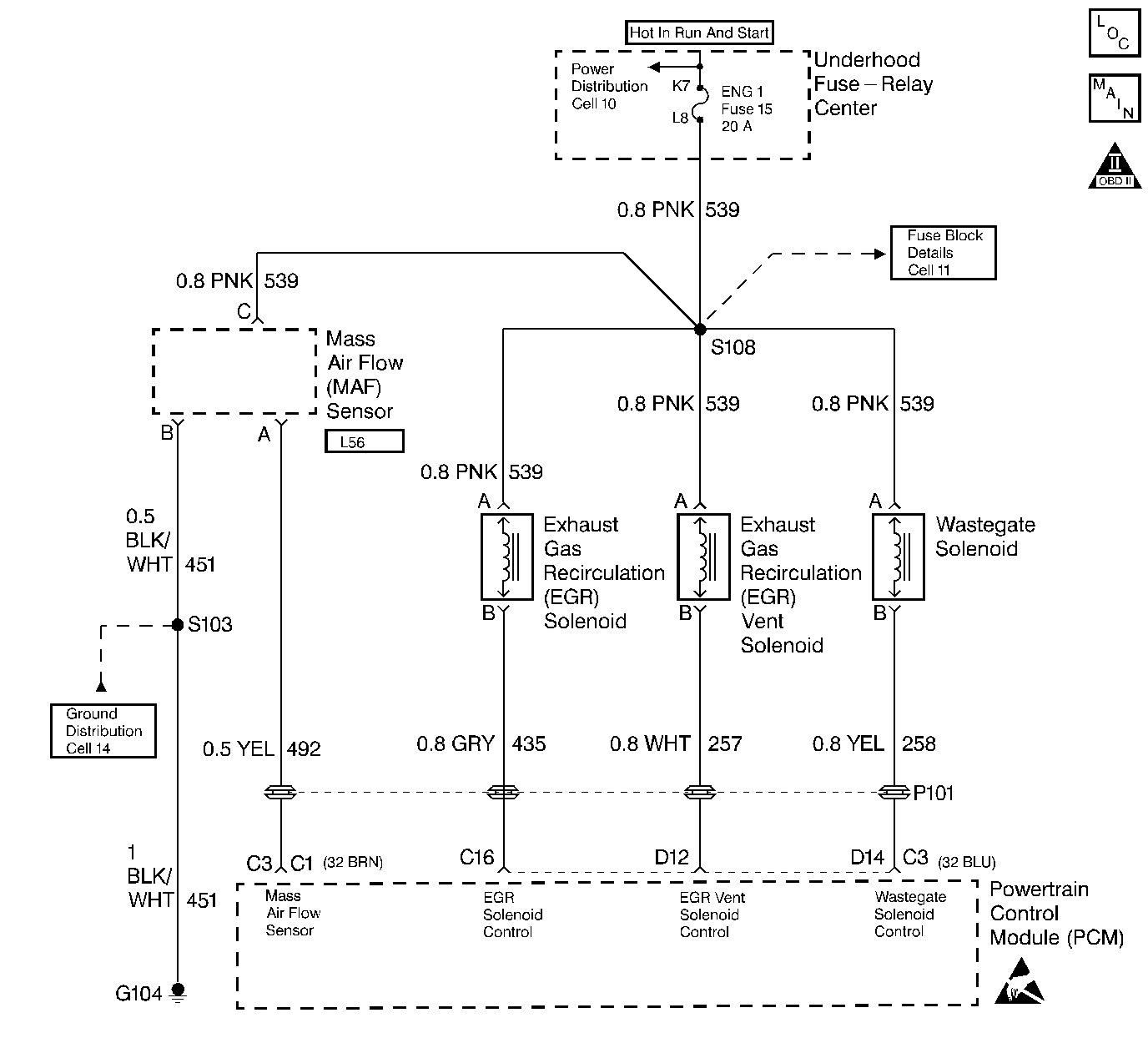
Circuit Description
The Mass Air Flow (MAF) sensor measures the amount of air entering the engine during a given time. The PCM uses the mass air flow information to monitor EGR flow rates. A large quantity of air entering the engine indicates an acceleration, high load situation or no EGR flow, while a small quantity of air indicates deceleration, idle or full EGR situations.
The PCM will monitor MAF and EGR pressures at different ranges to determine correct EGR flow rates. This is a type B DTC.
Conditions for Setting the DTC
| • | DTCs P0405, P0406, P0102 and P0103 not set. |
| • | All MAF and EGR Control Pressure tests complete (internal to PCM). |
| • | Engine at operating temperature. |
| • | IAT greater than or equal to 20°C (68°F) and less than or equal to 95°C (203°F). |
Action Taken When the DTC Sets
The MIL will illuminate on the second consecutive test fail.
Conditions for Clearing the MIL/DTC
| • | The PCM will turn the MIL off after three consecutive trips without a fault condition. |
| • | A History DTC will clear when forty consecutive warm-up cycles that the diagnostic does not fail (coolant temperature has risen 5°C (40°F) from start up coolant temperature and engine coolant temperature exceeds 71°C (160°F) that same ignition cycle. |
| • | Use of a Scan tool |
Diagnostic Aids
A vacuum leak will cause a DTC P1409. Carefully check all vacuum lines and components connected to the hoses for leaks or deformities. Check vacuum source to EGR solenoid assembly. Also check for small leak in EGR valve, and proper vacuum line routing, refer to Emission Hose Routing Diagram . Vacuum line ends can be trimmed to ensure a tight fit if length permits.
To run the diagnostic test the engine must be at operating temperature, vehicle in drive at idle for aproximately 1 minute, then with the vehicle in park hold engine rpm steady between 1500 and 2100 rpm for 30 seconds. If the diagnostic test fails to run, vehicle must be driven.
The Adaptive Learn Matrix (ALM) is used to adjust the EGR vacuum control based on Mass Air Flow (MAF). The ALM may change as a result of back pressure increases over the life of the vehicle or other engine system variations. The ALM is made up of sixteen cells (numbered from zero to fifteen) in which each cell covers a range of engine speed (RPM) and load (mm3).
Test Description
Number(s) below refer to the step number(s) on the Diagnostic Table.
-
This step checks for a vacuum source to the EGR valve.
-
This step checks for a malfunctioning EGR vent solenoid.
-
This step checks for a good vacuum source.
Step | Action | Value(s) | Yes | No | ||||
|---|---|---|---|---|---|---|---|---|
1 |
Important: Before clearing DTC(s) use the scan tool Capture Info to record freeze frame and failure records for reference, as data will be lost when Clear Info function is used. Was the Powertrain On-Board Diagnostic (OBD) System Check performed? | -- | ||||||
2 |
Is the vacuum greater than the specified value? | 15 in. Hg | ||||||
Is the vacuum greater than or equal to the specified value? | 15 in. Hg | |||||||
Does the EGR valve hold vacuum? | -- | |||||||
Is the vacuum greater than or equal to the specified value? | 15 in. Hg | |||||||
6 | DTC is intermittent. If no additional DTCs are stored, refer to Diagnostic Aids. If additional DTCs were stored refer to those table(s). Are any additional DTC(s) stored? | -- | Go to the Applicable DTC Table | Go to Diagnostic Aids | ||||
7 | Repair one of the following:
Is the action complete? | -- | -- | |||||
8 |
Was a problem found? | -- | ||||||
9 | Replace vacuum pump. Is the action complete? | -- | -- | |||||
10 | Repair one of the following:
Is action complete? | -- | -- | |||||
11 | Replace EGR valve. Refer to Exhaust Gas Recirculation Valve Replacement . Is the action complete? | -- | -- | |||||
12 |
Important: After Repairs, the EGR ALM cells must be reset (under special functions in scan tool). Are EGR ALM cells reset? | -- | -- | |||||
13 |
Does the Scan Tool indicate that this diagnostic Passed? | -- | ||||||
14 | Using the Scan Tool, select Capture Info, Review Info. Are any DTCs displayed that have not been diagnosed? | -- | Go to the Applicable DTC Table | System OK |
